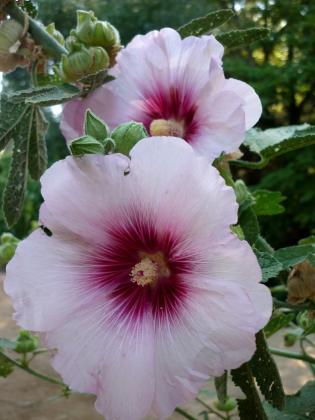Hollyhocks – Ancient world traveller
Backyard Horticulture
Hollyhocks, about 60 species in the Alcea genus, Alcea spp., are native to Asia and over thousands of years have made their way across the globe. The beautiful flowers are on tall stalks, usually about 4 to 8-feet, but can be taller. The alternate leaves are lobed, some toothed and can be 8-inches long and wide. The fruit is a schizocarp, a fruit with many sections, each holding a seed. Stalk, leaves and schizocarp are covered with hairs. There are usually five to nine, five-petaled flowers on the stalk, 2 or 3 inches across. Each has colors ranging from white, pink, purple, yellow and shades in between. Some varieties are almost black. They can be singular or grouped on the stalk.
In Iraq’s Shanidar Cave evidence of hollyhocks was found with the remains of Neanderthals dating from 35,000 to 65,000 years ago. The seeds were brought to Europe by soldiers returning from the Crusades. The Crusades were a series of wars sponsored by the Catholic Church in an attempt to recover the Holy Land from the Muslims and to convert people in other cultures to Christianity. These wars, 1095 to 1291, are referred to as Holy Wars. They were fought on horseback and when horses needed their hocks, lower legs, treated, a hollyhock salve or crushed leaves would be wrapped around their hocks, “holy hocks.”
Hollyhock flowers, young leaves and dried seeds are eaten raw; older leaves are cooked. Roots are boiled or fried. Candy is made from sap. It’s listed as a nectar plant in the Texas A&M University “Butterfly Garden” document at aggie-horticulture.tamu.edu .
A National Park Service, NPS, nps.gov, article “Courtyard Garden: Plant Origins & Historical Uses” said of hollyhocks, “Its edible flowers became very popular and were added to batters, soups and stews. Monks used the red flower petals as a food dye to color both wine and medicine.” Plant fibers were used to make fabric and paper. Dried stems were used as firewood. Children made dolls using the blooms as skirts.
Like the Crusaders’ horses, hollyhocks have relieved human injuries. Teething babies were given hollyhock root to chew. The NPS article said, “Hollyhocks were used to sooth the mucous membranes and treat coughs, colds and bronchitis. They were also used to soothe skin inflammation and rashes. In the 16th and 17th centuries, hollyhock tea was very popular for many health problems. Hollyhock species have been used since 300 B.C. to treat earache, mucus issues, hay fever and allergic rhinitis.” Alcea spp. is in the Food and Drug Administration Poisonous Plant Database at fda.gov.
Around the world the plant grows in a wide range of climates and soils, producing numerous seeds. Many cultures believe this symbolizes God’s love for everyone. The plant is a symbol of growth and rebirth. In many pictures of St. Joseph, he is seen with a hollyhock staff.
Hollyhocks were grown around homes particularly screening the privy. In polite society, you wouldn’t ask where the outhouse was, but would ask, where are your hollyhocks?


